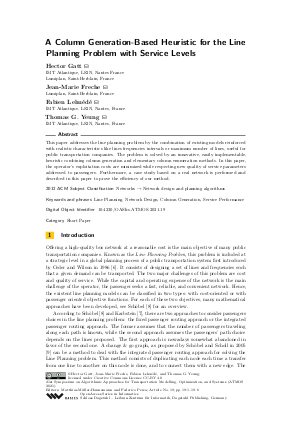A Column Generation-Based Heuristic for the Line Planning Problem with Service Levels (Short Paper)
Authors Hector Gatt, Jean-Marie Freche, Fabien Lehuédé, Thomas G. Yeung
-
Part of:
Volume:
21st Symposium on Algorithmic Approaches for Transportation Modelling, Optimization, and Systems (ATMOS 2021)
Part of: Series: Open Access Series in Informatics (OASIcs)
Part of: Conference: Symposium on Algorithmic Approaches for Transportation Modelling, Optimization, and Systems (ATMOS) - License:
 Creative Commons Attribution 4.0 International license
Creative Commons Attribution 4.0 International license
- Publication Date: 2021-09-27
File

PDF
OASIcs.ATMOS.2021.19.pdf
- Filesize: 1.21 MB
- 6 pages
Document Identifiers
Subject Classification
ACM Subject Classification
- Networks → Network design and planning algorithms
Keywords
- Line Planning
- Network Design
- Column Generation
- Service Performance
Metrics
- Access Statistics
-
Total Accesses (updated on a weekly basis)
0PDF Downloads0Metadata Views
Abstract
This paper addresses the line planning problem by the combination of existing models reinforced with realistic characteristics like lines frequencies intervals or maximum number of lines, useful for public transportation companies. The problem is solved by an innovative, easily implementable, heuristic combining column generation and elementary column enumeration methods. In this paper, the operator’s exploitation costs are minimized while respecting new quality of service parameters addressed to passengers. Furthermore, a case study based on a real network is performed and described in this paper to prove the efficiency of our method.
Cite As Get BibTex
Hector Gatt, Jean-Marie Freche, Fabien Lehuédé, and Thomas G. Yeung. A Column Generation-Based Heuristic for the Line Planning Problem with Service Levels (Short Paper). In 21st Symposium on Algorithmic Approaches for Transportation Modelling, Optimization, and Systems (ATMOS 2021). Open Access Series in Informatics (OASIcs), Volume 96, pp. 19:1-19:6, Schloss Dagstuhl – Leibniz-Zentrum für Informatik (2021)
https://doi.org/10.4230/OASIcs.ATMOS.2021.19
BibTex
@InProceedings{gatt_et_al:OASIcs.ATMOS.2021.19,
author = {Gatt, Hector and Freche, Jean-Marie and Lehu\'{e}d\'{e}, Fabien and Yeung, Thomas G.},
title = {{A Column Generation-Based Heuristic for the Line Planning Problem with Service Levels}},
booktitle = {21st Symposium on Algorithmic Approaches for Transportation Modelling, Optimization, and Systems (ATMOS 2021)},
pages = {19:1--19:6},
series = {Open Access Series in Informatics (OASIcs)},
ISBN = {978-3-95977-213-6},
ISSN = {2190-6807},
year = {2021},
volume = {96},
editor = {M\"{u}ller-Hannemann, Matthias and Perea, Federico},
publisher = {Schloss Dagstuhl -- Leibniz-Zentrum f{\"u}r Informatik},
address = {Dagstuhl, Germany},
URL = {https://drops.dagstuhl.de/entities/document/10.4230/OASIcs.ATMOS.2021.19},
URN = {urn:nbn:de:0030-drops-148885},
doi = {10.4230/OASIcs.ATMOS.2021.19},
annote = {Keywords: Line Planning, Network Design, Column Generation, Service Performance}
}
Author Details
References
-
M. H. Baaj and H. S. Mahmassani. Hybrid route generation heuristic algorithm for the design of transit networks. Transportation Research Part C: Emerging Technologies, 1995.

-
R. Baldacci, N. Christofides, and A. Mingozzi. An exact algorithm for the vrp based on the set partitioning formulation with additional cuts. Mathematical Programming, 2008.

-
D. Bertsimas, Y. S. Ng, and J. Yan. Data-Driven Transit Network Design at Scale. Operations Research, 2021.

-
R. Borndörfer, M. Grötschel, and M. E. Pfetsch. A Column-Generation Approach to Line Planning in Public Transport. Transportation Science, 2007.

-
R. Borndörfer and M. Karbstein. A Direct Connection Approach to Integrated Line Planning and Passenger Routing. Discrete Optimization, 2012.

-
A. Ceder and N. H. M. Wilson. Bus network design. Transportation Research Part B: Methodological, 1986.

-
M. Karbstein. Line Planning and Connectivity. PhD thesis, Mathematik und Naturwissenschaften der Technischen Universität Berlin, 2013.

-
A. Schöbel. Line planning in public transportation: models and methods. Springer, 2012.

-
A. Schöbel and S. Scholl. Line planning with minimal traveling time. ATMOS, 2005.

-
H. K. Suman and N. B. Bolia. Improvement in direct bus services through route planning. Transport Policy, 2019.

-
H. K. Suman, N. B. Bolia, and G. Tiwari. Perception of potential bus users and impact of feasible interventions to improve quality of bus services in Delhi. Case Studies on Transport Policy, 2018.

-
W.Y. Szeto and Y. Jiang. Transit route and frequency design: Bi-level modeling and hybrid artificial bee colony algorithm approach. Transportation Research Part B, 2014.

